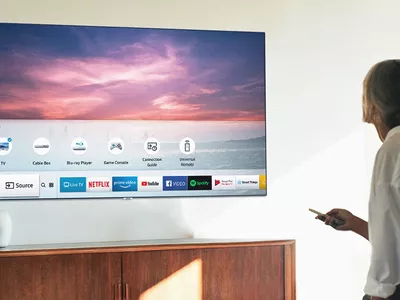
In 2024, What You Want To Know About Two-Factor Authentication for iCloud From your iPhone 14 Pro Max

What You Want To Know About Two-Factor Authentication for iCloud On your Apple iPhone 14 Pro Max
Hackers have stolen millions of iCloud credentials in the past and demanded Apple pay for a ransom. This is starting to become a thing of the past as Apple implemented two-factor authentication to secure your Apple ID.
However, it’s not always perfect, as sometimes you need to get past two-factor authentication on your iCloud for various reasons. That’s why this article will teach you how to set it up and bypass two-factor authentication on iCloud yourself if you need to. Read further to learn more.

Part 1: What Is Two-Factor Authentication for iCloud?
Not to be confused with Apple’s two-step authentication, the new and more secure two-factor authentication on iCloud introduces push notifications on your iOS device to keep your data safe. With Apple’s two unique ways to prove your identity, hackers will find it harder to access your personal and financial data.
Switching to two-factor authentication rather than two-step is becoming more common nowadays as security measures are more advanced. You can always switch your security measure at any point, but remember that two-factor authentication is now an essential way to keep your data safe.

Part 2: What Are the Benefits of Two-Factor Authentication?
Setting up two-factor authentication is a secure way to protect your device against unauthorized access. Adding another layer to your username and password highly reduces the chances of hackers obtaining your account.
Here are some of the benefits of activating two-factor authentication on your device.
- Improved security - A second form of identification aside from your password reduces the chance for someone to gain access to your information.
- Interconnectivity to mobile engagement - Two-factor authentication from businesses provides users with a stronger login system to ensure their information is safe in the digital world.
- Reduces Fraud - Due to the rise of identity theft in recent years, businesses risk losing trust, brand equity, and credibility. A secure authentication system adds a layer of protection to keep you secure.
Part 3: How To Set up Two-factor Authentication for iCloud?
If you haven’t set up two-factor authentication yet on your iCloud, here are the steps to activate it right now.
Step 1: On your Apple iPhone 14 Pro Max/iPad, go to Settings and tap your Apple ID profile at the top.

Step 2: Tap Password & Security and turn On Two-Factor Authentication.
Step 3: Enter a phone number to receive the two-factor code via an SMS or a phone call.
Step 4: Enter the 6-digit verification code received on your device and wait for the process the finish.
Note
You can turn off two-factor authentication within two weeks of enrollment. After that, it’s permanent.
Part 4: How To Turn Off Two-Factor Authentication on Your Apple iPhone 14 Pro Max?
As previously stated, once two-factor authentication is active on iCloud, you only have a two-week window to deactivate it again.
To get past two-factor authentication on iCloud, Go to Settings > your name > Password & Security. Tap Two-Factor Authentication and turn it Off again.
Meanwhile, here are the steps to learn how to bypass 2-step verification on iCloud on the web.
Step 1: Go to the Apple ID sign-in page and log in with your Apple ID.
Step 2: Click Sign-In and Security > Account Security.

Step 3: Click Turn Off Two-Step Verification. Answer a security question you’ve set up previously to finish the process.
Part 5: Is It Possible to Bypass Two-Factor Authentication for iCloud?
If you’re wondering how to bypass two-factor authentication on iCloud, the answer is no, you can’t. However, if you don’t have access to your trusted device, you can have a code sent to your trusted phone number via an SMS or an automated phone call to prove to Apple that you own the iCloud account.
If this is impossible, you should request account recovery to regain access to your account.
The easiest way to prevent this issue is by adding another phone number to your Apple ID so you’ll always have a backup. Here’s how.
Step 1: On your Apple iPhone 14 Pro Max, go to Settings and tap on your Apple ID > Password & Security.
Step 2: Tap Edit and choose to Add a Trusted Phone Number. You’ll have to enter your device’s passcode to continue.

Step 3: Enter your new phone number. Select a way to receive a verification code via sms or phone call and tap Send.
Step 4: Enter the verification code and wait for the process to finish.
Bonus Tips: Forgot Your iCloud Password? Here’s What To Do
Using special programs like Dr.Fone can help you recover your iOS device if you forget your iCloud password.
Dr.Fone’s key features are:
- Removes all types of iPhone locks such as Apple ID password, Face ID, Touch ID, and more.
- Bypass iCloud activation lock.
- Unlock your Apple iPhone 14 Pro Max without carrier restrictions.
- Remove MDM profile / bypass MDM lock without data loss.
Here’s how to use Dr.Fone if you forget your iCloud password.
Step 1: Download and install Dr.Fone .

Step 2: Click Screen Unlock on the main program window. On the next screen, click Bypass Activate Lock.

Step 3: Click Start to initiate the process of unlocking your Apple iPhone 14 Pro Max without an iCloud password.

Note
Your iPhone will need to be jailbroken before bypassing it using Dr.Fone.
After step 3, there are two possible outcomes for GSM and CDMA iPhone devices.
- If you own a GSM device, the unlocking will do no harm to your iOS device, and you can enjoy your Apple iPhone 14 Pro Max as usual.
- If the Apple iPhone 14 Pro Max is CDMA, you won’t be able to use the Apple iPhone 14 Pro Max device for phone calls, cellular data, and iCloud of your new Apple ID.
Conclusion
Turning on your iCloud’s two-factor authentication is necessary for today’s high-tech society. It ensures your information is always secure and minimizes the risk of getting hacked or having your account stolen. Once two-factor is active on your Apple ID, Apple provides you with a two-week window to deactivate it if you change your mind.
Meanwhile, if you forgot your iCloud and have a hard time recovering your account, you can try using dedicated programs like Dr.Fone to unlock your iOS device in a few steps.
How to Remove Activation Lock On the Apple iPhone 14 Pro Max Without Previous Owner?
Refurbished iPhones or iPads have been a viable option for more and more people, especially with the major cell phone manufacturer, Apple, offering official purchase channels. However, there are many people who buy used phones through non-acquaintances who trade in their own Apple devices. So, the question arises: How to remove the Find My iPhone activation lock without a previous owner? It has become the focus of people’s attention.
The reason can vary, but the recovery process can be exasperating. Fortunately, there are several right approaches and alternatives that can help with the situation. This article will introduce to you some simple and effective tricks to remove the activation lock, even if you lose help from previous owners.
Here is a video for you to learn how to remove Activation Lock on iPhone/iPad/iPod Touch:
Why Apple Devices Get locked by Activation Lock? [A Simple Overview]
In case some users don’t know Activation Lock, we are giving a simple introduction to it. According to Apple, “Activation Lock is a feature that’s designed to prevent anyone else from using your Apple iPhone 14 Pro Max, iPad, iPod touch, or Apple Watch if it’s ever lost or stolen. Activation Lock is enabled automatically when you turn on Find My iPhone. Even if you erase your device remotely, the Activation Lock can continue to deter anyone from reactivating your device without your permission. All you need to do is keep Find My iPhone turned on and remember your Apple ID and password.”
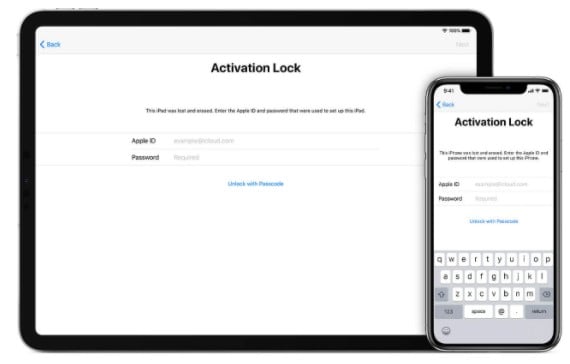
Admittedly, it has a good side to follow, but it does have drawbacks to specific people. Here are the pros and cons of Activation lock.
Pros
- Locate and play a sound by Find My iPhone on missing Apple devices, like iPhone, iPad, Mac, etc
- Protect data if a device is stolen
Cons
- Make the first using process more troublesome if you cannot acquire the iCloud login information from the previous owner, after buying a second hand iPhone
To solve this small problem, in this post, we provide you with four effective solutions to help you remove Activation Lock without a previous owner.
Method 1: Remove Activation Lock Without Previous Owner Using Dr.Fone [iOS 12.0 and up]
Without the credential, or iCloud login information from the previous owner, Dr.Fone - Screen Unlock (iOS) could do a big favor. It applies to both MacBook and Windows, and it is a professional bypass tool for an iCloud activation lock. The following steps will help you to remove the iCloud activation lock.
Dr.Fone will access your iOS devices with a couple of clicks. Follow the video instructions below to remove find my iPhone/ iPad activation lock without a previous owner:
Dr.Fone - Screen Unlock
Remove Remove Activation Lock without Password in Minutes
- Remove Apple ID/iCloud Account efficiently.
- Save your Apple iPhone 14 Pro Max quickly from the disabled state.
- Free your sim out of any carrier worldwide.
- Bypass iCloud activation lock and enjoy all iCloud services.

- Works for all models of iPhone, iPad, and iPod touch.
4,008,670 people have downloaded it
Step-by-step guide for Windows users
- Step 1. Launch and install Dr.Fone on your PC, and select Screen Unlock from its home page.
- Step 2. Select “_iOS” mode, and click “iCloud Activation Lock Removal” to bypass the iCloud Activation Lock. Then, tap “Start”_.

- Step 3. If your iOS device is running iOS/iPadOS 15.0 to 16.3, you can follow this process. However, for iOS/iPadOS 12.0 to 14.8.1, you must first jailbreak your device by following the Jailbreak Guide .
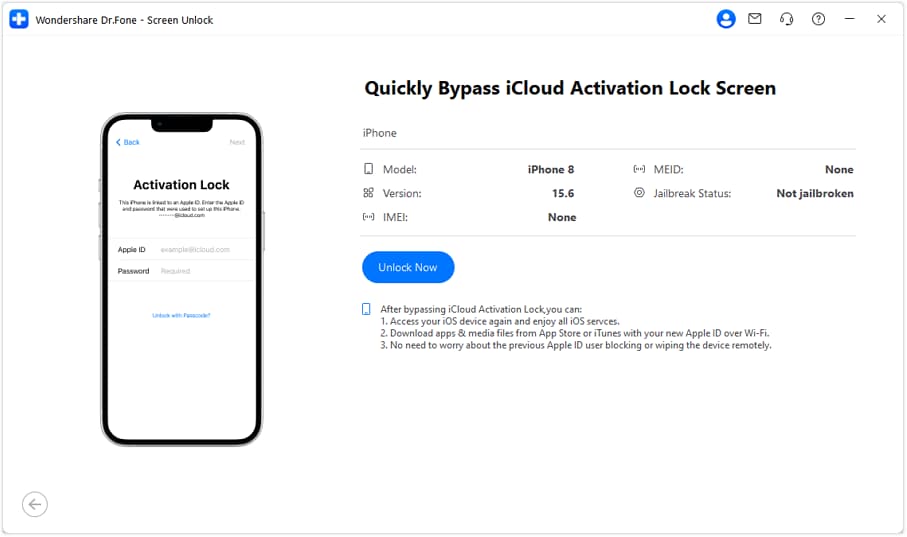
- Step 4. Then, please carefully read the agreement, confirm and tick it before start removing the iCloud activation lock.
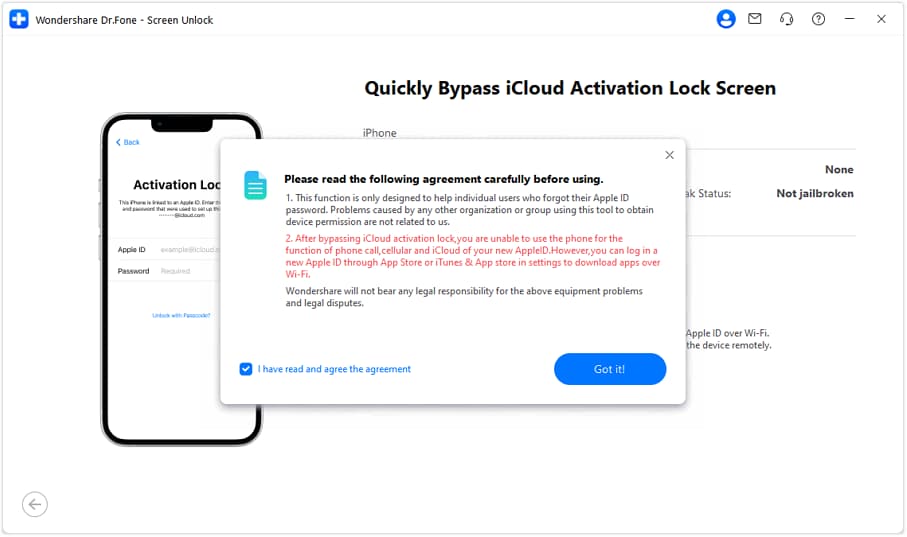
- Step 5. Next, follow the on-screen instructions to put your iOS device to enter DFU mode twice. And make sure your USB connection is stable, and you’ve unlocked the Apple iPhone 14 Pro Max device screen. When it is done, select Got It! button to continue.
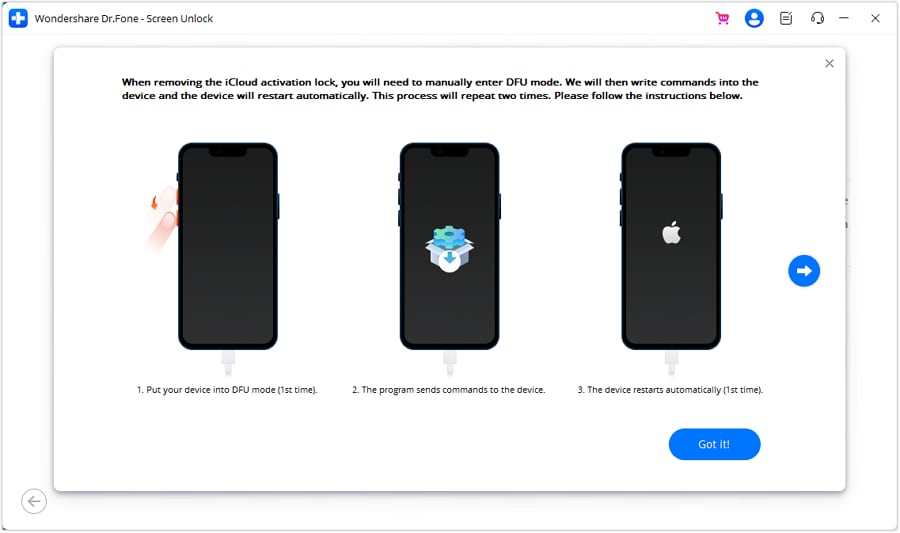
- Step 6. Then, Dr.Fone Screen Unlock will start the unlocking process, just take some minutes to its completion. After a while, it will show the following interface as below when it gets finished.

Method 2: Remove Activation Lock Without Previous Owner by Apple Official Support
This method could be very useful, but not that easy because you need to get proof of the purchase from the previous owner first. Once you get the required documents, everything goes simple. Go and contact Apple Support , Apple staff will be able to support you. They will verify the original owner of the phone and then help you unlock the Apple iPhone 14 Pro Max device. In addition to proof of purchase, they may ask for other documents as well as your identity cards. They will remove the Activation Lock from your device if your purchase documents are legit.
There are two ways to ask for Apple support:
- Offline method: Visit the Apple Store along with the purchase proof.
- Online method: Call Apple Support or visit its official website for remote assistance in removing the Activation Lock.
Their representatives will provide you with the necessary support and assistance during the process.
Method 3: Remove Activation Lock Without Previous Owner via DNS
Activation locks are difficult to get through, but fortunately, few methods work. DNS method can also help you bypass the activation lock and access your device. The best part is, you don’t need the previous owner or proof of purchase.
DNS method is an effective technique to remove find my iPhone activation lock without the previous owner. It works for the operating system running in the older versions. It is a simple technique for a technical person, and it works for both iPhone and iPad. This method utilizes the Wi-Fi DNS settings of the Apple iPhone 14 Pro Max device. Follow the steps:
- Step 1: Set up the Apple iPhone 14 Pro Max as a new device.
- Step 2: Connect to a Wi-Fi network on the Wi-Fi settings page. And tap the “_i_” icon next to your network name.
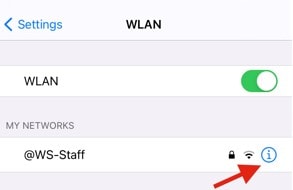
- Step 3: On the next screen, tap on the Configure DNS option.
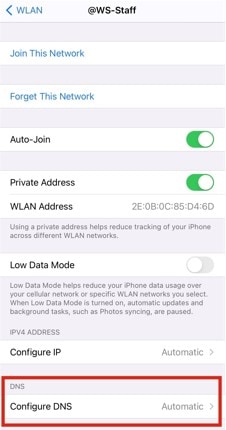
- Step 4: Choose the “_Manual_” option from the page as below.

Step 5: Tap “**+** Add Server”, and try one of the following DNS values:
USA: 104.154.51.7
South America: 35.199.88.219
Europe: 104.155.28.90
Asia: 104.155.220.58
Australia and Oceania: 35.189.47.23
Other: 78.100.17.60
Step 6: Your phone will be unlocked.
Pros
- This process can be manually done by devices’ Wi-Fi settings.
- It doesn’t need any external device or software.
Cons
- The process might be a little complicated for a non-technical person to operate.
- The method may not work for the latest versions of the Apple iPhone 14 Pro Max or iPad.
Method 4: Remove Activation Lock Without Previous Owner via the iCloud Web
If you can not reach the previous owner, but you are still in touch with them, they can still unlock your phone remotely by following a set of instructions. This whole process can be performed remotely with the help of iCloud web. If your previous owner cooperates, they can help with the process.
The process will involve a few steps to remove your Apple iPhone 14 Pro Max from their account remotely. After this process, you can set your device as a new phone. The activation lock will be permanently gone from your phone.
Here are the step-by-step instructions on removing my iPhone/iPad activation lock without the previous owner using the iCloud web. You can share these steps with the previous owner :
- Open iCloud website in a browser.
- Sign in to the existing iCloud account in use with the locked iPhone.
- Once you are logged in, click on the option that says Find iPhone.
Now you can remotely perform actions on your phone. Further :
- Click on the drop-down named All Devices and choose your Apple iPhone 14 Pro Max.
- Click on Erase iPhone.
Final Words
By now, you are familiar that there are many ways to bypass activation lock. So, If you face a situation with the activation lock, you will have a couple of options to get through the situation. Just decide the correct method and approach according to your circumstances and availability of resources. If you are a seller, you should disable the activation lock before selling your phone. Erasing the Apple iPhone 14 Pro Max device back to factory settings will not put the buyer in any trouble.
To Disable Activation Lock
- Go to settings > Tap your name at the top of the list > Tap iCloud > Tap Find My iPhone > Toggle the “Find My iPhone” > Type your Apple ID password.
To Reset The Device
- Go to settings > General > Reset > Click “erase all settings” >Give confirmation > Wait until the process is complete.
We hope this post will help you figure out the right way to remove the Find My iPhone/ iPad Activation Lock without a previous owner. If you have any questions, please leave us in the comment section below.
How to fix iCloud lock on your Apple iPhone 14 Pro Max and iPad
There’s no sad thing like working your entire life just to get yourself the latest brand of your favorite iPhone or iPad device only for you to realize that the all-too-important iCloud option has been locked out of reach either by the owner or by the company that sold it to you. Without the iCloud option, you can’t back up your information, and neither can you secure your privacy. It’s for this reason that I have with me the how-to-fix iCloud lock method. A lot of people have always argued that the iCloud lock cannot be surpassed due to certain factors. However, thanks to technology, I’m here to prove all the doubting Toms otherwise.
With the how-to-fix iCloud lock method at hand, you no longer have to worry or get stressed when purchasing an iPhone or an iPad for your own pleasure or comfort. In this article, I’m going to lay down three of the most basic and simple steps on how to fix iCloud lock in a matter of minutes.
Method 1: Fix iCloud lock via Apple
In the recent past, Apple has tried to bar its users from unlocking iCloud storage perhaps due to the increased cases of theft and privacy breach. It, however, seems too late for the company to stop this iCloud lock fix process as they nowadays help their users in unlocking the iCloud lock. The following is one of the most commonly used iCloud lock fix methods offered by Apple as a company.
Step 1: Enter your Login Details
To gain access to your device, you first need to enter your unique Apple ID and your password and log into your device.
Step 2: Find My iPhone
Once you have gained access to your device, locate the “Find My iPhone” option and turn it off. This particular option functions by locking your iCloud as a security measure. It’s also the main reason why you can’t access your iCloud account.
Step 3: Restore your Device
With the “Find My iPhone” option turned off, reset your device by deleting all your data and settings. You can do this by following this procedure. Click on Settings> General> Reset> Erase Content and all Settings. This process will completely erase your device to its default state. You should also note that this procedure may vary from one version to another.
Step 4: Sign In
With your phone back to its default state, sign in using your Apple details as explained in step 1. Once you are logged in, just set up your iPad or iPhone with new details. Also, try to access the iCloud option to make sure that the lock is no longer available. Once you are satisfied with what you see, simply sign out and sign in back again just to be sure. If everything is okay, then you are good to go.
Method 2: How to fix iCloud lock through the owner
Another easy iCloud lock fix method is by directly contacting the owner. In most circumstances, many iPhone and iPad users usually lock up the iCloud option as a way of protecting their privacy. If the person who sold you the Apple iPhone 14 Pro Max device happens to be the real owner, then he/she should be in a position to give you the iCloud unlock codes.
This approach, however, has a downside. It’s only applicable if you can track down the rightful owner of the iPad or iPhone device or if the company that sold it to you know how to remove the lock. If you can’t get through to the owner, then I would recommend you to look for other alternatives as we’re going to see in this article.
Method 3: How to fix iCloud lock via Official iPhoneUnlock
One of the greatest, safest and swift methods of fixing the iCloud lock is by using the Official iPhoneUnlock . With the help of the iCloud Activation Lock Removal process, you can easily bypass the iCloud Activation Lock and remove it completely from your device. The following is a detailed process on how you can seamlessly do it with the peace of mind that your data and all valuable information will be kept in place.
Step 1: Purchase the Service
For you to unlock the iCloud lock, using this method, you first have to obtain the rights to do so. Securing these rights is simply done by purchasing their services. The price at which you’ll be charged will depend on the model of your device. To buy these services, visit the webiste of Official iPhoneUnlock and select “iCloud Unlock” to its “iCloud Unlock/Activation Lock Removal” feature, then enter your IMEI number from the drop-down list as illustrated below. Once you have located your phone make or model, click on the “Add to Cart” tab. The price at which you are going to be charged will be displayed on your right-hand side.
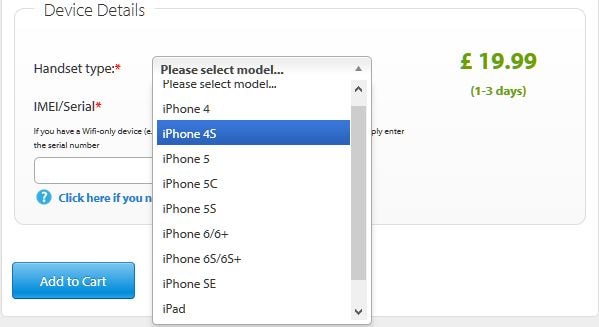
Step 2: Enter your Email Address
A new page with your purchase details as shown below will open up. Enter your email address as requested and click on the “Continue” button. Make sure that you have entered the correct email address as it will be used to inform you that your iCloud lock is no longer active.
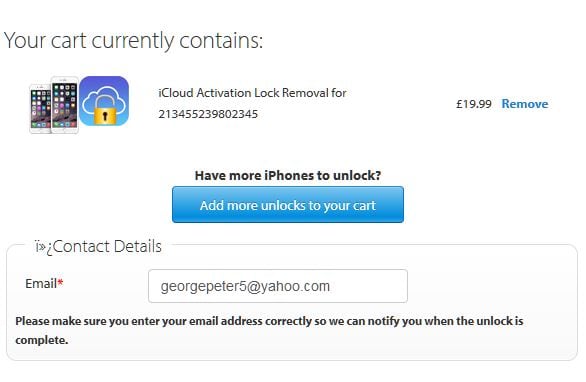
Step 3: Pay Options
Once you have entered your email address, a new interface requesting you to choose your preferred payment method will be displayed. Choose your best-preferred method by clicking on the “Pay with Credit or Debit Card” tab and enter your bank details. Once you submit your payment, your iCloud lock will be unlocked after a period of between 2-3 days. A confirmation email will be sent to your designated email address. Just like that, your iCloud lock fix is removed, and you are free to use iCloud.
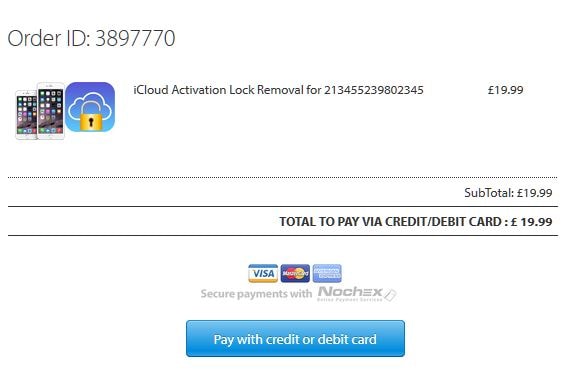
Method 4: How to Fix iCloud with Efficient Tool
If you aren’t able to fix iCloud lock with the provided methods above, we would like to recommend you Dr.Fone – Unlock (iOS) – one of its kind tools that work when you wish to unlock screen locks effortlessly. It shows great compatibility with the latest iPhones and iOS versions. In addition, you don’t need to be tech-savvy to play with this tool. Let us know how it works to fix iCloud lock.
Dr.Fone - Screen Unlock
Fix the “iPhone Is Disabled Connect to iTunes” Error In 5 Minutes
- The welcoming solution to fix “iPhone is disabled, connect to iTunes”
- Effectively remove iPhone lock screen without the passcode.
- Works for all models of iPhone, iPad, and iPod touch.
- Fully compatible with the latest iOS.

3,238,377 people have downloaded it
How to fix iCloud Lock using Dr.Fone – Screen Unlock (iOS)
Step 1: Allow the Program to Start
After you download and install Dr.Fone – Screen Unlock (iOS) from its official website, launch it. Now, with the help of a USB cord, plug your device into the PC. Click “Unlock” from the main interface.

Step 2: Select Unlock Apple ID
When the next screen appears, you are required to hit on the “Remove Apple ID”.

Step 3: Key in the Password
As the next step, make sure to enter the screen password. Move ahead to trust the computer thereby letting the program scan the Apple iPhone 14 Pro Max device further.
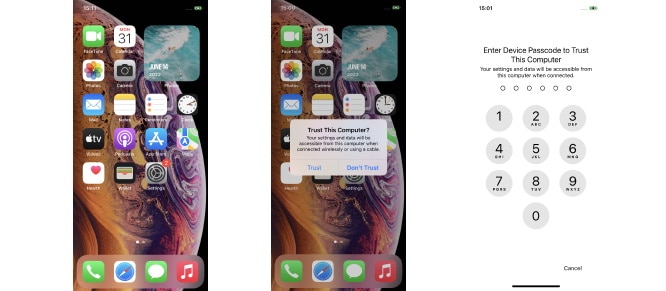
Step 4: Enter Recovery mode
You will be given some instructions on the following screen. Ensure to follow them carefully and put your device into recovery mode.

Step 5: Get iCloud Lock Fixed
When the Apple iPhone 14 Pro Max device restarts, the program will start fixing the iCloud lock. You just need to wait patiently until the process is over.

Step 6: Check the iCloud ID
In the last, you will receive a new window where you can check whether you have fixed iCloud or not.

As we have seen, different methods of how to fix iCloud lock are available to choose from. The method you chose will solely depend on your own preferences. The various methods as we have seen have their own advantages and disadvantages. Some will delete your entire data while some will charge you a particular amount. What you should always keep in mind is the fact that you can fix iCloud lock at your own will and wish. You no longer have to be worried about being locked out of your iCloud account.
Also read:
- [New] Room Arrangement for Immersive VR Experience for 2024
- [Updated] Navigating Picture-in-Picture Features in Firefox for 2024
- Bypass Activation Lock From iPhone XS Max - 4 Easy Ways
- How to fix iCloud lock from your Apple iPhone 14 Plus and iPad
- How to Unlock iCloud Activation Lock and iCloud Account From iPhone SE (2022)?
- In 2024, 4 Things You Must Know About Apple iPhone 8 Plus Activation Lock
- In 2024, Bypass iCloud Activation Lock with IMEI Code From Apple iPhone 15
- In 2024, New Guide How To Check iCloud Activation Lock Status On Your iPhone 8 Plus
- In 2024, Unlocking an iCloud Locked iPad and Apple iPhone 11 Pro
- Pivotal Insights Into Online Story Crafting
- The Ultimate Guide to Bypassing iCloud Activation Lock on Apple iPhone X
- The Ultimate Guide to Choosing a Smart Weather Station: Spotlight on Netatmo
- Transforming Taskbar Functionality: 6 Essential Upgrades for Windows 11
- Ultimate Guide: Solve Your AirPods' Silent Dilemma with These 10 Troubleshooting Tips
- Win7 HDMI Sounds Not Playing? Here's How to Get It Working Again
- Windows Scan: Back to Operational State
- XFire's Rival Reimagined: The Next Evolution in Chat Apps for Gamers Post-Discord Era
- Title: In 2024, What You Want To Know About Two-Factor Authentication for iCloud From your iPhone 14 Pro Max
- Author: Lydia
- Created at : 2024-10-25 16:09:33
- Updated at : 2024-10-26 16:05:13
- Link: https://activate-lock.techidaily.com/in-2024-what-you-want-to-know-about-two-factor-authentication-for-icloud-from-your-iphone-14-pro-max-by-drfone-ios/
- License: This work is licensed under CC BY-NC-SA 4.0.
